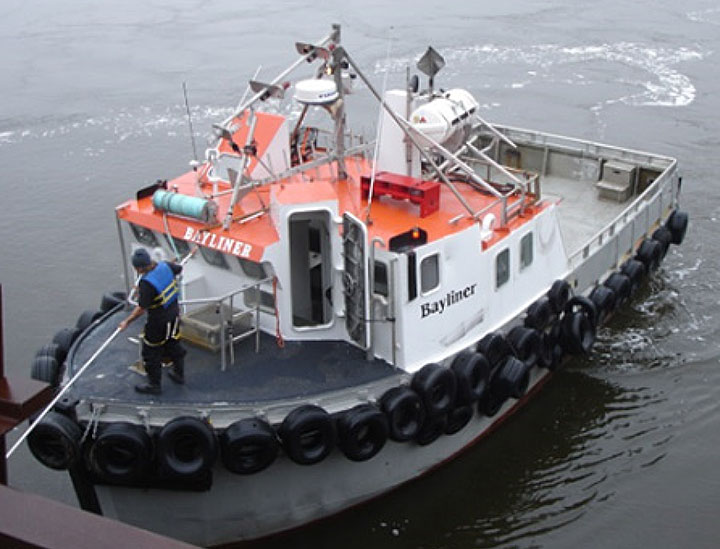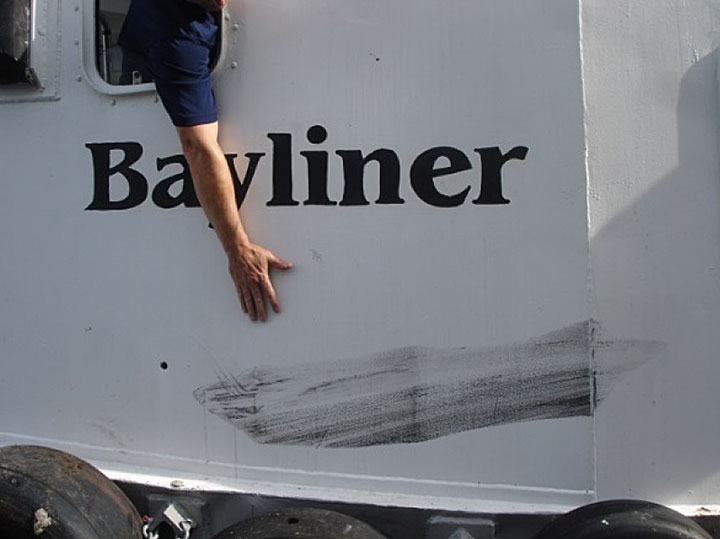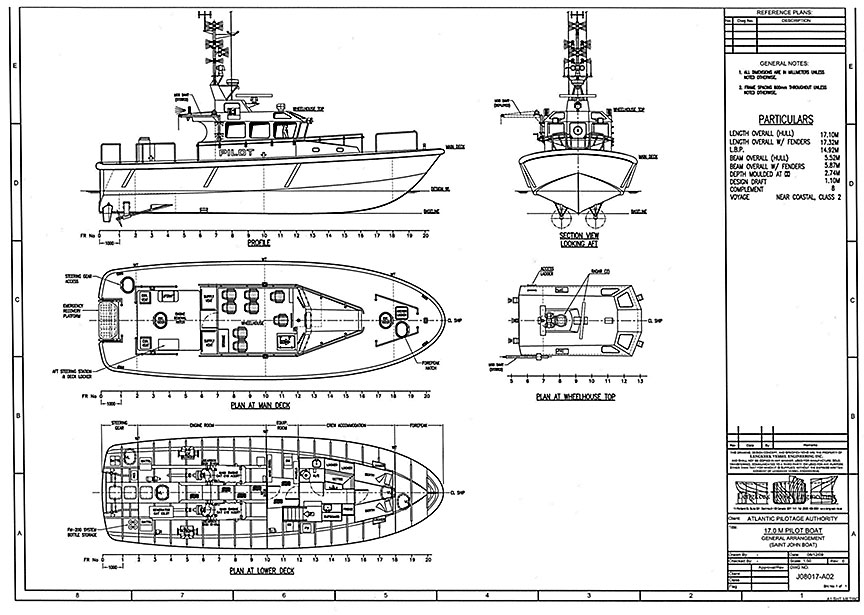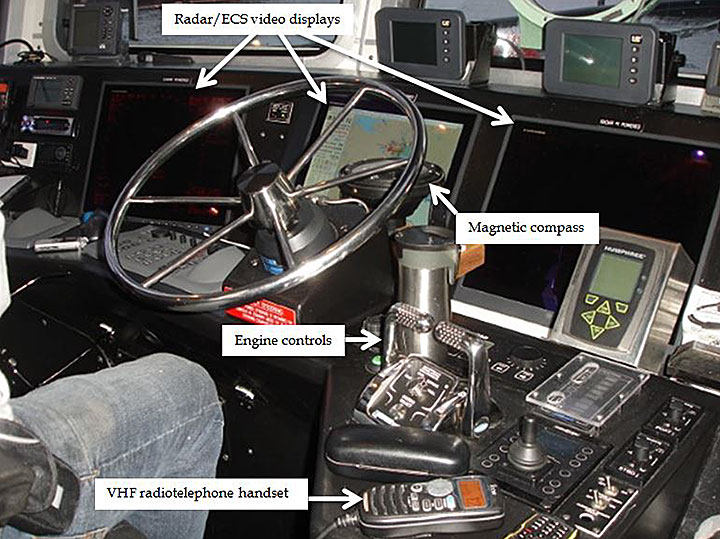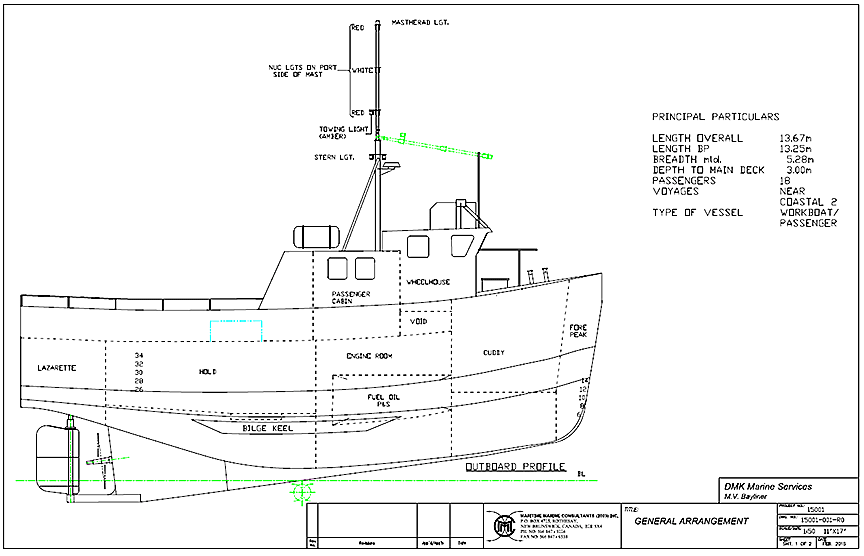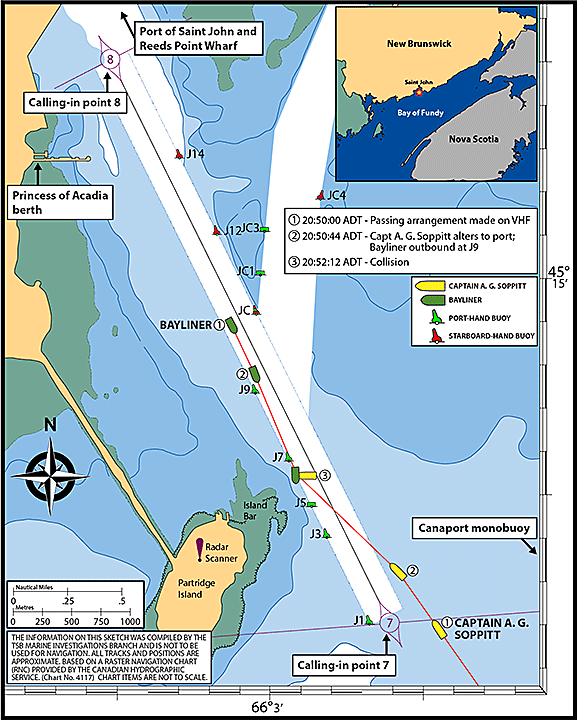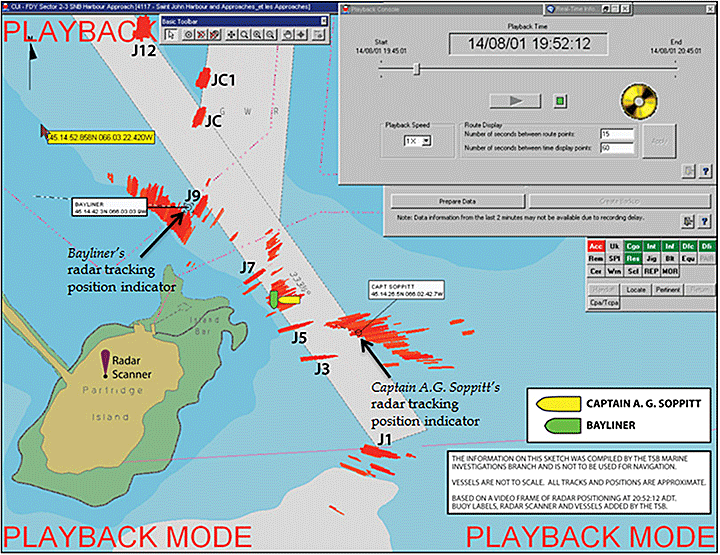Marine Investigation Report M14A0348
The Transportation Safety Board of Canada (TSB) investigated this occurrence for the purpose of advancing transportation safety. It is not the function of the Board to assign fault or determine civil or criminal liability.
Collision
Pilot boat Captain A.G. Soppitt and passenger vessel Bayliner
Main channel into the Port of Saint John
Saint John, New Brunswick
Pilot boat Captain A.G. Soppitt and passenger vessel Bayliner
Main channel into the Port of Saint John
Saint John, New Brunswick
Summary
On 01 August 2014, at 2052 Atlantic Daylight Time, the pilot boat Captain A.G. Soppitt and the small passenger vessel Bayliner collided in dense fog while both vessels were transiting the main channel that leads into the Port of Saint John, New Brunswick. There were no injuries or pollution. Both vessels sustained minor damage.Le présent rapport est également disponible en français.
Factual information
Particulars of the vessels
| Name of vessel | Captain A.G. Soppitt | Bayliner |
|---|---|---|
| Official number | 837143 | 808649 |
| Port of registry | Saint John, NB | Yarmouth, NS |
| Flag | Canada | Canada |
| Type | Pilot boat | Passenger/work boat |
| Gross tonnage | 47.0 | 39.63 |
| LengthFootnote 1 | 17.1 m | 12.42 m |
| Draft at time of occurrence | Forward: 1.3 m Aft: 1.3 m |
Forward: 1.4 m Aft: 2.6 m |
| Built | 2012 | 1987 |
| Propulsion | 2 diesel engines (1066 kW total), twin-screw | 1 diesel engine (252 kW), single-screw |
| Passengers | 1 | None |
| Crew | 2 | 3 |
| Registered owner | Atlantic Pilotage Authority Halifax, NS |
DMK Marine Services Ltd. Saint John, NB |
Description of the vessels
Captain A.G. Soppitt
The Captain A.G. Soppitt is a purpose-built aluminium vessel designed and equipped for transporting marine pilots (Photo 1, Appendix A). The vessel has a hard chine,Footnote 2 deep-vee planing hull and a maximum speed of 24 knots. Propulsion is provided by two 5-bladed propellers measuring 89 cm in diameter, each driven by a diesel engine through a custom gear-driven marine transmission.Footnote 3 The vessel has 2 spade-type rudders. A series of 9 large windows provides visibility on the bridge.The integrated bridge includes a set of three 20-inch video screens that can display navigational information from 2 marine radars and 2 electronic charting systems (ECS) (Appendix B). The bridge is also equipped with 2 very high frequency (VHF) radiotelephones with digital selective calling (DSC), a magnetic compass, a satellite compass, an autopilot, a depth sounder, a weather station, and an automatic identification system (AIS).Footnote 4 The vessel is also fitted with a manually operated fog horn, a thermal camera, and an automatic horn, but neither the thermal camera nor the automatic horn was operational at the time of the occurrence.
The radars on the Captain A.G. Soppitt each have video plotters that allow the user to display electronic charts, plot the vessel's track, plot other vessels' tracks, enter waypoints/routes, and create a radar map of lines and marks. The radars have a target trails feature that, when activated, generates shading to show the track (trail) of targets moving across the display. This feature enables the operator to observe the vessel’s own movement as well as other vessels’ tracks, and can be used to assist in collision avoidance. Two electronic bearing lines and ranges can also be used to determine if an approaching vessel is on a steady bearing and, therefore, if a risk of collision exists. An electronic chart can also be overlaid onto the radar image to show the position of radar targets in relation to the charted area.
The vessel is owned by the Atlantic Pilotage Authority (APA), a federal Crown corporation responsible for providing marine pilotage service to the major ports in Atlantic Canada. The APA operates vessels throughout Atlantic Canada, and the Captain A.G. Soppitt is 1 of 2 pilot boats servicing the Saint John harbour and approaches.
Bayliner
The Bayliner is a small aluminium vessel of closed construction (Photo 2). The deckhouse is located forward of amidships and contains the conning station, the galley, and the entrance to the crew accommodation below deck (Appendix C). The navigation and communication equipment is located near the seated conning station on the starboard side of the vessel and includes a radar, a depth sounder, an autopilot, a magnetic compass, a fog horn, 2 VHF DSC radiotelephones, 2 global positioning system (GPS) receivers, and an ECS. The ECS is loaded with colour charts for the area and also displays AIS data.Footnote 5 The vessel was not equipped with an AIS transponder, nor was one required.The Bayliner is 1 of 5 small vessels operated by DMK Marine Services Ltd., a family-owned marine repair and service company located at the old marine wharf in the Port of Saint John. These vessels provide assistance to vessels, wharfs, and the Canaport monobuoyFootnote 6 by undertaking repairs, performing pollution patrols, providing divers, and transporting personnel, passengers and cargo. The Bayliner has also occasionally been used to transport marine pilots to and from large vessels in the area when the regular pilot boats were not available.
Description of the main channel leading into the Port of Saint John
The main channel leading into the Port of Saint John is 1.45 nautical miles (nm) in length and 0.08 nm in width (Appendix D). The south end of the main channel begins at calling-in point (CIP) 7 and joins the harbour entrance at CIP 8. The channel is delimited by 3 red starboard-hand buoys (J12, J14, J16) and 5 green port-hand buoys (J1, J3, J5, J7, and J9).Footnote 7 A bifurcation junction (JC) buoy indicates the secondary channel to Courtney Bay. The inbound course is 333.5° true (T) and the outbound course is 153.5°T.History of the voyage
Captain A.G. Soppitt
At 1951,Footnote 8 the Captain A.G. Soppitt departed the Port of Saint John with the master and a deckhand on board. The vessel was bound for the Canaport monobuoy to embark a pilot from a tanker and transport the pilot to Reeds Point wharf, located within the port on the east side of the harbour (Appendix D).At around 1956, Marine Communications and Traffic Services (MCTS) Fundy TrafficFootnote 9 contacted the Captain A.G. Soppitt on VHF channel 12 and advised the master that the tug Swellmaster was inbound from Canaport and was at the berth where the Princess of Acadia ferry docks (Appendix D). Shortly thereafter, the master of the Captain A.G. Soppitt contacted the Swellmaster by VHF radiotelephone and identified himself by saying “Swellmaster, pilot boat.”Footnote 10 The master of the Captain A.G. Soppitt then advised, “I'm to the east here; starboard-to-starboard work for you?” The Swellmaster replied “Roger, thank you.” The vessels continued on their voyages and undertook the agreed-upon passing arrangement.
At 2039, the master of the Captain A.G. Soppitt advised Fundy Traffic that the pilot was on board and they were inbound for the Saint John harbour. The vessel was in dense fog and the master was manually steering from the centre chair on the bridge. He was also keeping a visual lookout and monitoring the radars.Footnote 11 The deckhand was seated in a chair on the port side, adjacent to the master, and was keeping a lookout through the bridge windows. The pilot was seated in the starboard aft chair and was not involved in the navigation of the vessel.
At 2045, the Captain A.G. Soppitt's main ECS froze in position 45.198° N, 065.992° W with a vessel heading of 000°. The time displayed on the ECS also jumped back by 1 minute and 4 seconds.Footnote 12 The bridge team was not using this ECS and was unaware that it had failed.
As the Captain A.G. Soppitt approached CIP 7, the master adjusted the range on the starboard radar to better observe targets in the channel. At 2049, as the Captain A.G. Soppitt was proceeding at 17 knots, the master contacted Fundy Traffic and advised “We're at checkpoint 7.” He also asked if there was any traffic in the channel. Fundy Traffic replied “Affirmative sir, you have the Bayliner outbound now just at the junction [JC] buoy.”
Bayliner
At 2041, the Bayliner departed the old marine wharf within the Port of Saint John with the master and 2 deckhands on board. The master advised Fundy Traffic that the Bayliner was outbound to anchorage DFootnote 13 to rendezvous with the oil tanker Island Express. The Bayliner was operating at a reduced speed of about 9 knots in the thick fog. The 2 deckhands were maintaining a lookout through the deckhouse windows and the open forward door. The master was seated on the starboard side of the bridge and was monitoring the radar, compass, ECS, and VHF.At 2046, the master of the Bayliner called Fundy Traffic on VHF channel 12 and advised that the vessel was at CIP 8. Fundy Traffic in turn reported that “the pilot boat is inbound now, just past CIP 6, followed by the Spitfire.” The master of the Bayliner acknowledged with “Roger that” and then reduced speed to an estimated 6 or 7 knots because the fog was becoming even thicker.
Events prior to the collision
Around 2050, as the Captain A.G. Soppitt was crossing the CIP 7 line about 100 metres east of the entrance channel and proceeding at 17 knots, the master called the Bayliner on VHF and identified himself by saying “Bayliner, pilot boat.” The master of the Bayliner responded with “Bayliner back.” At this time, the vessels were about 0.9 nm apart and were approaching each other at a combined speed of around 25 knots. Neither vessel was sounding signals to indicate that it was in restricted visibility. The master of the Bayliner checked the ECS, which was showing the Captain A.G. Soppitt to the east side of the main channel.The master of the Captain A.G. Soppitt then proposed to proceed along the port-hand buoysFootnote 14 by stating: “I'll hug the greens, if that works for you?”Footnote 15 The master of the Bayliner promptly replied, “Works for us.”
At 2050:44, the master of the Captain A.G. Soppitt altered course by 16 degrees to port to move closer to the port-hand buoys on the west side of the channel. He also reduced speed to 13 knots. The Bayliner altered course to starboard, which also put it closer to the port-hand buoys on the west side of the channel.
As the Bayliner was passing the J9 port-hand buoy, the master checked the ECS and observed the Captain A.G. Soppitt entering the east side of the channel. The master zoomed in the ECSFootnote 16 to better see the chart features and the Captain A.G. Soppitt's AIS position, and decreased the radarFootnote 17 range scale on the display to better observe the targets in the channel. He then ordered the crew to keep a close watch out for the Captain A.G. Soppitt, as it was in the vicinity.
Meanwhile, at the Saint John MCTS centre, one of the Fundy Traffic officers on duty was using radar to monitor vessels in the main channel. However, at 2051:31, the radar tracking position indicator for the Captain A.G. Soppitt swoppedFootnote 18 to clutter on the radar, so the radar was no longer depicting the vessel's position accurately (Appendix E). Thirteen seconds later, the radar tracking position indicator for the Bayliner swopped to the J9 buoy radar echo, so the depiction of the Bayliner's position was now also inaccurate. At the time, the Fundy Traffic officer was not aware that these target swops had occurred.
Just before 2052, the Captain A.G. Soppitt was inbound at 9.4 knots and heading for the J7 port-hand buoy, while the Bayliner was outbound on the west side of the channel passing close to the buoy. The master of the Bayliner altered to starboard and reduced speed to move away from the Captain A.G. Soppitt, which was quickly approaching. At 2052, the vessels were only 0.16 nm apart, but both masters continued with the manoeuvre, expecting the other to alter to the east.
Shortly after 2052, the pilot on board the Captain A.G. Soppitt observed through the fog that the Bayliner was crossing to port ahead of the vessel and shouted a warning to the crew. The master saw the Bayliner's wake and immediately moved both engine controls to the full astern position. Meanwhile, on the Bayliner, the deckhand standing lookout on the port side saw the Captain A.G. Soppitt through the fog on the port bow and called out a warning to the crew that it was going to hit them. The master of the Bayliner promptly turned the steering wheel to starboard and set the engine control to neutral.
Seconds later, the Captain A.G. Soppitt was at full astern on both engines and had turned to port so that the vessel was now roughly perpendicular to the Bayliner. At about 2052:12, the Captain A.G. Soppitt's bow struck the Bayliner's port side and then continued to ride up onto the Bayliner's bulwark rubber side fenders until the D-shaped bow fender struck and rubbed against the side of the Bayliner's wheelhouse, approximately 0.7 metre below the forward window.
Events following the collision
After the collision, the crew on each vessel confirmed that there were no injuries or significant damage, and the masters exchanged this information in person with the vessels alongside. During the ensuing discussion about the collision, there was some confusion about the agreed-upon passing arrangements. Although the vessels had been proceeding towards one another, both masters had understood that they were to “hug” (stay close to) the port-hand buoys on the west side of the channel.At 2057, the master of the Bayliner reported to Fundy Traffic that the Captain A.G. Soppitt had collided with them. Fundy Traffic requested clarification about whether the Captain A.G. Soppitt had collided with a buoy or the Bayliner. The master confirmed that the Captain A.G. Soppitt had collided with the Bayliner. The master also reported that there were no injuries and only minor damage to the Bayliner above the waterline. The Bayliner then resumed its voyage to the Island Express.
At 2059, the Captain A.G. Soppitt confirmed with Fundy Traffic that there were no injuries or damage.
Damage to the vessels
Damage to both vessels was limited to black scuff marks where the rubber fenders had made contact (Photo 3 and Photo 4).Environmental conditions
At the time of the occurrence, there was restricted visibility of less than 30 metres due to dense fog. The wind was from the southwest at 5 knots, and the tide was about 2.35 metres above chart datum and ebbing. A high tide of 7.1 metres had occurred at 1606, and the next low tide of 1.5 m was at 2221. Sunset was at 2053.Personnel certification and experience
Captain A.G. Soppitt
The master held a 150 Gross Tonnage, Domestic Master certificate issued in 2010 and a Restricted Operator's certificate, Maritime Commercial (ROC-MC).Footnote 19 The master had also completed the Transport Canada Simulated Electronic Navigation Level 2 course in April 2010. He had worked on APA pilot boats for the previous 4 years, including the last 2 years as master.In 2007, he was issued a Fishing Master, Fourth Class up to 100 Gross Tonnage on a Near Coastal Voyage certificate, and had also fished commercially as master of his own vessel for the past 7 years.Bayliner
The master held a Master, Limited for a Vessel of Less Than 60 Gross Tonnage certificate and a small vessel machinery operator certificate, both of which were issued in August 2013. He also held a ROC-MC. Prior to 1990, he had worked as deckhand and master of small commercial fishing boats and charter boats owned by DMK Marine Services and, in 2013, returned as master with the same company.Vessel certification
Both the Captain A.G. Soppitt and the Bayliner were equipped and certificated in accordance with existing regulations.International Regulations for Preventing Collisions at Sea
The International Regulations for Preventing Collisions at Sea (COLREGS) are an international convention that establishes, among other things, the rules of conduct to follow at sea when a risk of collision exists between vessels. The rules have been adopted by Canada and “apply to all vessels upon the high seas and in all waters connected therewith navigable by seagoing vessels.”Footnote 20 Governments or states may adopt special rules for their waterways. These special rules, however, shall conform as closely as possible to the COLREGS.Footnote 21The COLREGS require vessels to, at all times, maintain a proper lookout by all available means appropriate in the prevailing circumstances and conditions so as to make a full appraisal of the situation and the risk of collision.Footnote 22
The COLREGS further stipulate that in areas of restricted visibility, vessels underway must sound 1 prolonged blast at intervals of not more than 2 minutes.Footnote 23 Although vessels must sound this signal at least every 2 minutes, shorter intervals are desirable when other vessels are nearby.
In addition, Rule 19 of the COLREGS, which deals with the conduct of vessels in restricted visibility, specifies that
(a) This Rule applies to vessels not in sight of one another when navigating in or near an area of restricted visibility.
(b) Every vessel shall proceed at a safe speed adapted to the prevailing circumstances and conditions of restricted visibility. A power-driven vessel shall have her engines ready for immediate manoeuvre.
(c) Every vessel shall have due regard to the prevailing circumstances and conditions of restricted visibility when complying with the Rules of Section I of this Part [Conduct of Vessels in Any Condition of Visibility].
(d) A vessel which detects by radar alone the presence of another vessel shall determine if a close-quarters situation is developing and/or risk of collision exists. If so, she shall take avoiding action in ample time, provided that when such action consists of an alteration of course, so far as possible the following shall be avoided:
(i) an alteration of course to port for a vessel forward of the beam, other than for a vessel being overtaken,
(ii) an alteration of course towards a vessel abeam or abaft the beam.
(e) Except where it has been determined that a risk of collision does not exist, every vessel which hears apparently forward of her beam the fog signal of another vessel, or which cannot avoid a close-quarters situation with another vessel forward of her beam, shall reduce her speed to the minimum at which she can be kept on her course. She shall if necessary take all her way off and in any event navigate with extreme caution until danger of collision is over.Footnote 24
Very high frequency radiotelephone communications
The International Maritime Organization (IMO) has recognized that standardized communications and terminology contribute to the safe operation of ships and to greater safety of navigation.Footnote 25 To this end, the IMO has adopted guidelinesFootnote 26 that include the following:- The words “I” and “YOU” should be used prudently and should indicate to whom they refer.
- Where a message is received and only acknowledgement of receipt is needed, say “received.”
- Where a message is received and acknowledgement of the correct message is required, say “received, understood,” and repeat the message if considered necessary (e.g. “Message: Your berth will be clear at 08.30 hours. Reply: Received, understood. Berth clear at 08.30 hours.”).
- Where the message contains instructions or advice, the substance should be repeated in the replyFootnote 27 (e.g. “Message: Advise you pass astern of me. Reply: I will pass astern of you.”).
- when a risk of collision with another ship is deemed to exist under the provisions of the Collision Regulations;Footnote 28
- when the navigation safety call of another ship indicates that a close-quarters situation may develop; and
- when doubt exists as to the actions or the intentions of another ship.Footnote 29
Nothing in these Regulations shall be construed asThe regulations also require that a navigation safety call, as is practicable, will indicate the identity of the vessel, location of the vessel, and the intended course of action.Footnote 31
(a) relieving a ship of its obligation to sound the appropriate whistle signals required by, or
(b) permitting a ship to carry out maneuvers that contravene the provisions of the steering and sailing rules of the Collision Regulations that apply in the area being navigated by the ship.Footnote 30
A British Marine Guidance Note entitled Operational Guidance on the Use Of VHF Radio and Automatic Identification Systems (AIS) at Sea states that
There have been a significant number of collisions where subsequent investigation has found that at some stage before impact, one or both parties were using VHF radio in an attempt to avoid collision. The use of VHF radio in these circumstances is not always helpful and may even prove to be dangerous.Footnote 32The note further states that, even where there is positive identification between vessels, there is still the possibility of a misunderstanding due to imprecise or ambiguously expressed messages.
VHF use between vessels in the main channel
The meeting of vessels in the Saint John main channel occurs port-to-port or starboard-to-starboard, depending on the type of vessel and destination. A port-to-port passing is standard and occurs when the outbound vessel's destination is south or west of the channel. However, a starboard-to-starboard passing is common when the outbound vessel's destination is east of the channel.When the masters of local small commercial vessels make passing arrangements in the Saint John main channel, a common practice is to communicate over VHF radiotelephone using phrasing that varies. For example, sometimes the issuer may indicate that the passing will be port-to-port or starboard-to-starboard, while other times, the issuer may indicate that the issuer's vessel will pass along the port-hand or starboard-hand buoys. The receiver may either repeat the instruction or simply acknowledge receipt of the message. On occasion, before ending the communication, the issuer may again repeat the port-to-port or starboard-to-starboard passing instruction.
Marine Communications and Traffic Services
MCTS provides communications and traffic services for the marine community 24 hours a day, 7 days a week to ensure the safe and efficient movement of vessels. MCTS has several objectives, notably to contribute to the safety of life at sea and to the safety and efficiency of navigation.Footnote 33 In fulfilling these roles, MCTS officers may provide traffic recommendations when it becomes evident that a vessel should take, but has not yet taken, appropriate action in response to information provided. The MCTS standards specify that MCTS officers shall at no time have, or attempt to have, the conduct of a vessel; MCTS communication shall be expressed in such a manner as to ensure that they cannot be regarded as assuming conduct of a vessel.Footnote 34In this occurrence, the MCTS officer advised the Captain A.G. Soppitt of the presence of the Bayliner when a request for traffic in the channel was made. The communication between the 2 vessels when they made their passing arrangement was heard on the MCTS frequency.
Use of navigational equipment
The Captain A.G. Soppitt was fitted with a variety of navigational equipment, including radars with charting and tracking features. The radars incorporated automatic radar plotting aid (ARPA) and also included several features to assist in collision avoidance, such as variable range rings, bearing lines, track plotting capability, target trails, and chart overlay.In this occurrence, the master of the Captain A.G. Soppitt was using the radars to navigate the vessel. The radar displays were in ship's head-up mode and relative motion. In this configuration, the radars were solely providing a real-time picture of the situation around the vessel. The anti-collision features had not been activated and were therefore not being used, nor was the ECS being monitored.
Plan continuation bias
Plan continuation bias occurs when a person or team continues with a plan even though conditions have changed to an extent that would not have necessarily been acceptable if they had been present at the beginning of a task. Decisions can be influenced by a wide range of factors such as individual perception of the situation, experience, training, expectations, time constraints, and contextual elements. Once a decision is made, there is a tendency for individuals to continue with the selected course of action unless there are compelling reasons not to do so.Analysis
Events leading to the collision
As the Captain A.G. Soppitt and the Bayliner rapidly approached each other in dense fog, both masters were proceeding so as to remain close to the port-hand buoys due to a misunderstanding about the passing arrangement that had been communicated over the very high frequency (VHF) radiotelephone. The misunderstanding had resulted from a brief and informal communication, whereby the master of the Captain A.G. Soppitt had proposed a starboard-to-starboard passing arrangement by stating “I'll hug the greens,” but the “I'll,” as spoken, was not easily discernible over the VHF. The master of the Bayliner therefore understood the statement to be “Hug the greens” for a port-to-port arrangement, which was consistent with the Bayliner's course at the time and destination south of the channel. As well, the master of the Bayliner was aware that the Captain A.G. Soppitt had a pilot on board who would be disembarked at Reeds Point wharf on the east side of the harbour.There were indications that a close-quarters situation was rapidly developing. However, both masters continued with their understanding of the passing arrangement, believing the other vessel would take the expected action and navigate to the opposite side of the channel. The masters reduced speed and increased the alertness of their lookouts, but they did not attempt to call each other on VHF to clarify the passing arrangements, nor did they take all way off their vessels. Persevering with the manoeuvre is indicative of plan continuation bias.
The Bayliner was at reduced speed proceeding across the Captain A.G. Soppitt's bow to port when the vessels came into sight of each other at less than 30 metres apart. Both masters took immediate action: the Captain A.G. Soppitt put both engine controls to full astern, while the Bayliner turned to starboard and unclutched its engine. However, the Captain A.G. Soppitt's speed was such that the vessel's forward momentum could not be stopped in time to avoid the collision.
Making passing arrangements on very high frequency radiotelephones
When passing arrangements are made by VHF radiotelephone, it is important that navigators make use of communication best practices, such as those set out in the International Maritime Organization (IMO) guidance, in order to reduce the risk of misunderstandings.As a precaution, given the reduced visibility around the time of the occurrence, the master of the Captain A.G. Soppitt enquired about traffic in the main channel and, once informed of the presence of the Bayliner, communicated with the other vessel using VHF radiotelephone to make a passing arrangement.
However, the bridge-to-bridge VHF radiotelephone exchange that was used to initiate the passing arrangement did not conform to communication best practices with respect to the following:
- the radio communication did not confirm both vessels' positions and intended courses;
- the instruction was not repeated to close the loop and avoid the misunderstanding;
- the word “I” was used without specifying to whom it referred (e.g. I, the Captain A.G. Soppitt and you, the Bayliner); and
- the phonetically distinct terms “port-to-port” and “starboard-to-starboard” were not used to reduce the risk of misunderstanding about how the passing would be executed.
In the Saint John main channel, VHF radiotelephone communications initiated between vessels that are approaching each other usually include the vessels' names, but do not always include their positions, headings, speeds, destinations, intended courses and any vessel restrictions. Moreover, these passing arrangements do not always include the words “port-to-port” or “starboard-to-starboard,” and the instructions are not always repeated back to close the loop and confirm a shared understanding. Since the buoys provide a good navigational reference, over time there is a propensity to use them in the wording of the passing arrangement instead of the words “port” or “starboard.” This creates a risk of misunderstanding as to which vessel is to stay close to which buoys.
As highlighted in British Marine Guidance Note MGN 324 (M+F), misunderstandings may arise due to imprecise or ambiguously expressed messages. Insufficient or poor exchanges can result in the vessels not sharing a common understanding of how the vessels will navigate safely past each other.
If VHF radiotelephone communication used to make passing arrangements does not adhere to guidelines and best practices, there is an increased risk of misunderstandings and collisions.
Use of navigational equipment
To ensure the safe passage of a vessel, navigators must make full use of all available navigational equipment. This is essential to accurately monitor the vessel's progress and detect any possible risk of collision, especially in reduced visibility.The radars on the Captain A.G. Soppitt had various charting and target tracking features that, when in use, help the master to determine the closest point of approach (CPA) of other vessels, among other things. However, at the time of the occurrence, none of these features on the radar had been enabled to continuously monitor the Bayliner's CPA, nor were the electronic chart systems being monitored or overlaid with the radar targets to show the Captain A.G. Soppitt's position in relation to other targets in the channel. As a result, the master of the Captain A.G. Soppitt did not have all navigational information that the radars could have provided, such as tracking of the Bayliner's movement as well as its CPA, available to him to make a full appraisal of the situation, which may have prompted early action to avoid the collision.
The navigational equipment on the Captain A.G. Soppitt was not optimally configured with all available charting and target tracking features to assist in monitoring both vessels' positions.
Sound signals in restricted visibility
In areas of restricted visibility, vessels are required to use sound signals to warn other vessels of their presence to help prevent collisions.In this occurrence, neither vessel was sounding signals, even though the vessels were fitted with the required equipment. It was not the common practice on either vessel to sound the appropriate signals when operating in reduced visibility. Nevertheless, the use of the sound signals provides an additional cue, particularly for the lookout, to detect the presence of another vessel and assess its proximity. Given that there were lookouts on both vessels, the sounding of a whistle or horn might have provided another indication of the developing close-quarters situation and might have initiated an earlier response to avoid a potential collision.
If a vessel underway in restricted visibility is not sounding the required signals, other vessels in proximity may not be alerted to a potential close-quarters situation for which prompt and effective avoidance action must be taken.
Findings
Findings as to causes and contributing factors
- The very high frequency radiotelephone communication used to arrange the passing led to a misunderstanding that resulted in the Captain A.G. Soppitt being manoeuvred for a starboard-to-starboard passing and the Bayliner for a port-to-port passing.
- The navigational equipment on the Captain A.G. Soppitt was not optimally configured or used with all available charting and target tracking features to assist in monitoring both vessels' positions for collision avoidance.
- Both masters continued along their intended route, without additional radiotelephone communication, in the belief that the other vessel would take action and alter course towards the opposite side of the channel.
- Once in sight of each other, both masters took immediate action to avoid collision, but the Captain A.G. Soppitt's speed was too great to prevent the collision, and its bow struck the Bayliner.
Findings as to risk
- If very high frequency radiotelephone communication used to make passing arrangements does not adhere to guidelines and best practices, there is an increased risk of misunderstandings and collisions.
- If a vessel underway in restricted visibility is not sounding the required signals, other vessels in proximity may not be alerted to a potential close-quarters situation for which prompt and effective avoidance action must be taken.
Other findings
- At 2045:42, the position and heading on the main electronic charting system (ECS) on board the Captain A.G. Soppitt froze and only resumed indicating the vessel's actual position at start-up around 0730 the next morning.
Safety action
Safety action taken
DMK Marine Services Ltd.
DMK Marine Services Ltd. has fitted the Bayliner with a Class B automatic identification system (AIS). This means that other vessels fitted with AIS will be able to obtain navigational information for the Bayliner (position, heading, etc.) that can help them when determining if there is a risk of collision.This report concludes the Transportation Safety Board's investigation into this occurrence. The Board authorized the release of this report on 03 August 2015. It was officially released on 11 August 2015.
Appendices
Appendix A – Captain A.G. Soppitt general arrangement
Source: Atlantic Pilotage AuthorityAppendix B – Captain A.G. Soppitt conning position
Appendix C – Bayliner general arrangement
Source: DMK Marine Services Ltd.Appendix D – Main channel leading into the Port of Saint John
Appendix E – Screenshot of Fundy Traffic radar
Source: Marine Communications and Traffic Services (MCTS) Fundy Traffic radar (screenshot at the time of the collision, 20:52:12), with TSB annotations.Footnotes
- Footnote 1
-
Units of measurement in this report conform to International
Maritime Organization Standards or, where there is no such standard, are
expressed in the International System of Units.
- Footnote 2
-
The term “hard chine” refers to a small interior angle where the
sides of the hull and the bottom of a flat or V-bottom hull intersect.
- Footnote 3
-
The custom marine transmission on the Captain A.G. Soppitt provides 15 times faster clutch response and 10 times faster to full torque than the standard marine transmission.
- Footnote 4
-
Automatic identification system (AIS) is an automatic tracking
system used on vessels and by vessel traffic services for identifying
and locating vessels through the electronic exchange of data with AIS
base stations, satellites, and other nearby vessels.
- Footnote 5
-
The electronic charting system (ECS) screen on the Bayliner displays
the name, bearing, range, and closest point of approach (CPA) of other
vessels fitted with an automatic identification system (AIS).
- Footnote 6
-
The Canaport monobuoy is a floating platform anchored in deep water
approximately 3.4 nautical miles to the southeast of the main channel.
The monobuoy is used by large, deep-draft tankers for mooring, and
loading or unloading.
- Footnote 7
-
Starboard-hand buoys mark the starboard (right) side of a channel or
the location of a hazard that must be kept on the vessel's starboard
side when the vessel is proceeding upstream. Port-hand buoys mark the
port (left) side of a channel or the location of a hazard that must be
kept on the vessel's port side when the vessel is proceeding upstream.
- Footnote 8
-
All times are Atlantic Daylight Time (Coordinated Universal Time [UTC] minus 3 hours), unless otherwise stated.
- Footnote 9
-
The Marine Communications and Traffic Services (MCTS) centre at
Saint John uses the radio identifier Fundy Traffic to provide vessel
traffic services. Fundy Traffic uses very high frequency (VHF) channel
12. In this occurrence, all VHF radio communications between vessels and
Fundy Traffic were made using VHF channel 12.
- Footnote 10
-
During very high frequency radiotelephone conversations with other
vessels and with Fundy Traffic, the Captain A.G. Soppitt is routinely
referred to as the “pilot boat” by all parties.
- Footnote 11
-
The starboard radar was on the 0.75 nautical mile (nm) range with
the centre offset astern on the radar display. The port radar was on the
0.5 nm range and was centred on the radar display.
- Footnote 12
-
The electronic charting system did not start updating data again
until the next morning at 0732:31, when the system time also jumped
ahead by 5 minutes and 25 seconds.
- Footnote 13
-
Anchorage D is located in a southerly direction from the Saint John main channel.
- Footnote 14
-
A starboard-to-starboard passing commonly occurs when the outbound vessel’s destination is east of the channel. The Bayliner
often headed east to the Canaport monobuoy soon after a tanker had
moored at the monobuoy, but on this voyage was headed southerly for
anchorage D.
- Footnote 15
-
On the Marine Communications and Traffic Services recording of the conversation, “I’ll” is not easily discernable.
- Footnote 16
-
The electronic charting system was on ship’s head-up and relative motion.
- Footnote 17
-
The radar was on ship’s head-up and relative motion.
- Footnote 18
-
A target swop occurs when incoming radar data for a tracked target
become incorrectly associated with another tracked target or a
non-tracked radar echo. Target swopping is known to occur regularly in
this area of the Saint John main channel.
- Footnote 19
-
A Restricted Operator’s certificate, Maritime Commercial is issued
by Industry Canada and qualifies mariners to operate very high frequency
radiotelephones on commercial vessels operating within the North
American A1 Sea Area, as defined in the Canadian Coast Guard publication
Radio Aids to Marine Navigation, available at:
http://www.ccg-gcc.gc.ca/Marine-Communications/Home (Last accessed 06
March 2015).
- Footnote 20
-
Collision Regulations, C.R.C. c. 1416, Schedule 1,
International Regulations for Preventing Collision at Sea with Canadian
Modifications, 1972, Rule 1(a).
- Footnote 21
-
Ibid, Rule 1(b).
- Footnote 22
-
Ibid, Rule 5.
- Footnote 23
-
Ibid, Rule 35.
- Footnote 24
-
Ibid, Rule 19.
- Footnote 25
-
International Maritime Organization (IMO), Standard Marine
Communication Phrases (SMCP), Resolution A.918(22), 25 January 2002,
available at:
http://www.imo.org/blast/blastDataHelper.asp?data_id=24571&filename=A918(22).pdf
(Last accessed 27 February 2015).
- Footnote 26
-
International Maritime Organization (IMO), Proper Use of VHF
Channels at Sea, Resolution A.954(23), 26 February 2004, available at:
http://www.imo.org/blast/blastDataHelper.asp?data_id=27131&filename=A954(23).pdf
(Last accessed 27 February 2015).
- Footnote 27
-
This type of communication, whereby the information provided is
repeated back in the reply, is known as “closed-loop” communication and
is used to reduce the risk of a misunderstanding.
- Footnote 28
-
Collision Regulations, C.R.C. c. 1416, Schedule 1, International Regulations for Preventing Collision at Sea with Canadian Modifications, 1972.
- Footnote 29
-
VHF Radiotelephone Practices and Procedures Regulations,
SOR/81-364, available at:
http://laws-lois.justice.gc.ca/eng/regulations/SOR-81-364/FullText.html
(Last accessed 06 March 2015).
- Footnote 30
-
Ibid.
- Footnote 31
-
Ibid.
- Footnote 32
-
Maritime and Coastguard Agency (MCA) United Kingdom, Marine Guidance Note MGN 324 (M+F), Operational Guidance on the Use Of VHF Radio and Automatic Identification Systems (AIS) at Sea, available at: https://mcanet.mcga.gov.uk/public/c4/solasv/m_notice/mgn/mgn324.pdf (Last accessed 06 March 2015).
- Footnote 33
-
Canadian Coast Guard, Marine Communications and Traffic Services (MCTS), Marine Communications and Traffic Services Standwards Manual, Version 1.0, 16 June 2003, Foreword.
- Footnote 34
- Ibid.

